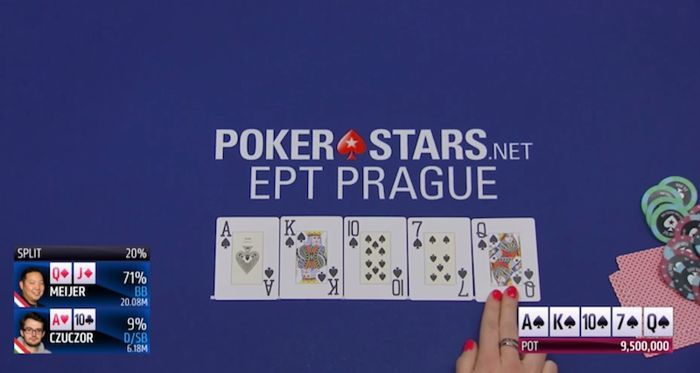Hand Review: Bluffing Dutchman Jasper Meijer Executes Another

Covering live poker tournaments for a living affords me the opportunity to see countless thousands of hands played out, many of which offer interesting and potentially valuable insights into how players — both amateurs and professionals — play the game. In this ongoing series, I'll highlight hands I've seen at the tournaments I've covered and see if we can glean anything useful from them.
The Scene
It's been awhile since we reviewed a hand here, but last time in this space we looked over a key hand between Jasper Meijer and Marton Czuczor in which the former pulled off a big overbet bluff during three-handed play with the European Poker Tour Prague Main Event title on the line.
This week, we'll examine another huge bluff from Meijer, one which came a little later during heads-up play with Czuczor after David Peters went bust in third place.
By then Czuczor had pulled nearly even and the two had made a deal for the majority of the money, but they were still playing for €50,000 and the title, and the pendulum had begun to swing back toward Meijer.
At the time of this hand they were playing 150,000/300,000/50,000 with Meijer leading with more than 24 million and Czuczor sitting on about 11 million.
The Action
Czuczor held A♥10♣ and raised to 700,000. Meijer three-bet to 2.1 million with Q♦J♦. Czuczor called, and the two saw a flop come A♠K♠10♠. Meijer bet 2.6 million and Czuczor called.
The turn was the 7♠, and both players checked to see the river bring the Q♠, putting a fifth spade on the board. Meijer shoved all in for just over 6 million effective and Czuczor folded.
Concept and Analysis
Czuczor makes his standard open with a very strong holding for heads-up play, only to see his Dutch opponent — who was playing quite aggressively throughout the final table once he got some chips — pop him with a reraise.
Ace-ten is a really good hand heads-up, but while Meijer had been quite aggro, it's still a not hand you're excited to get almost 40 big blinds in with preflop, in most cases. Here Czuczor wants to keep his opponent's bluffs in, and jamming would probably leave him flipping or dominated by everything with which Meijer would call, so the only sensible play is to call.
Meanwhile Meijer has a hand that flops well, and he knows his opponent is at an awkward stack depth that's a bit too deep to shove most hands. He hadn't been three-betting all that much, and in those cases, if you wait for a monster, your opponents are just going to fold a lot of marginal hands with which you want them to peel.
The flop hits both players hard, but they also both have to be wary given the three spades on the board. Meijer flops a Broadway straight and Czuczor two pair, but the former would potentially be drawing dead if a spade hit or he's already against a flush, while the latter would be drawing slim to four outs.
Thus Meijer elects to fire out a fairly large continuation bet of 2.6 million, just over half-pot. Czuczor has to be a little worried about this sizing, as the most likely explanation is that his opponent has a big hand and wants to get value and/or ensure a one-spade hand can't draw profitably. Czuczor calls to see what develops on the turn, and another spade arrives.
Now both players check, but each has to be wondering if the other has a spade. Czuczor may be slightly less likely of the two to have one since he checked back, plus Meijer might be checking his whole range here to balance out the many times he doesn't like this turn.
The river produces a very interesting spot as the board now reads A♠K♠10♠7♠Q♠, meaning both players are now playing the board. Being out of position in these cases can actually be beneficial, as you get the first chance to stab at the pot given that your opponent checked back the previous street.

The pot was 9.5 million and Czuczor had almost 6.2 million back. Meijer saw his opportunity and overbet-shoved.
Could Meijer have bet less and gotten a fold? Possibly. But Czuczor might have called to try to chop in that case. With his whole tournament at risk, Meijer figured his opponent was unlikely to hero it off even if he suspected a bluff.
And what hands could Czuczor have that would call and win? Something like Ax9♠ or AxJ♠ makes sense, but that's such a small subset of hands. The J♠ would be the most likely card for Czuczor to hold since he called a three-bet preflop and presumably has decent cards, but offsuit hands with a jack that happens to be a spade just don't make up that much of his range.
Plus Meijer has the chips to put his opponent to the test. If he's called and loses, he still has a decent stack with which to work, while Czuczor would have to consider putting his tournament at risk were he to bluff all in here in the event Meijer checked or decide to call it off in this case.
The role of big-stack bully can be exaggerated in many cases, but this was a spot where Meijer used it to his advantage and pushed his opponent off of a chop, delivering a large pot and putting Czuczor on his last legs before he was eliminated just a few hands later.









